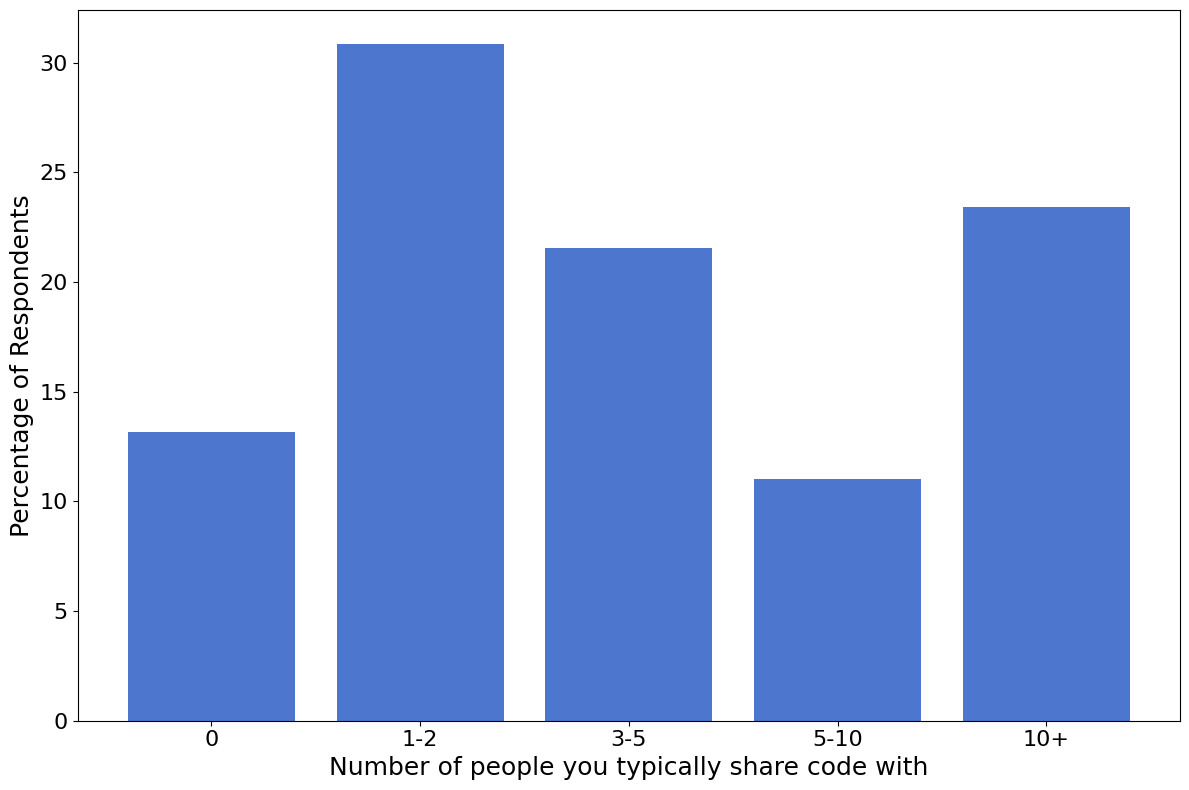Community#
A summary of the demographic information of the NumPy survey respondents.
Show code cell source
fname = "data/2021/numpy_survey_results.tsv"
column_names = [
'age', 'gender', 'lang', 'lang_other', 'country', 'degree', 'degree_other',
'field_of_study', 'field_other', 'role', 'role_other', 'version', 'version_other',
'primary_use', 'share_code', 'programming_exp', 'numpy_exp', 'use_freq', 'components',
'use_c_ext', 'prog_lang', 'prog_lang_other', 'surv2020'
]
demographics_dtype = np.dtype({
"names": column_names,
"formats": ['<U600'] * len(column_names),
})
data = np.loadtxt(
fname, delimiter='\t', skiprows=3, dtype=demographics_dtype,
usecols=list(range(11, 33)) + [90], comments=None, encoding='UTF-16'
)
glue('2021_num_respondents', data.shape[0], display=False)
Demographics#
Age#
Of the 522 survey respondents, 456 (87%) shared their age.
The majority of respondents are in the age groups 25-34 and 35-44. Very few respondents are older than 55, and even fewer are younger than 18.
Show code cell source
# Ignore empty fields and "prefer not to answer"
drop = np.logical_and(data['age'] != '', data['age'] != 'Prefer not to answer')
age = data['age'][drop]
labels, cnts = np.unique(age, return_counts=True)
ind = np.array([5,0,1,2,3,4])
labels, cnts = labels[ind], cnts[ind]
fig, ax = plt.subplots(figsize=(12, 8))
ax.bar(
np.arange(len(labels)),
100 * cnts / age.shape[0],
tick_label=labels,
)
ax.set_ylabel('Percentage of Respondents')
ax.set_xlabel('Age Group')
ax.set_title("Age Distribution of Survey Respondents");
fig.tight_layout()
glue('2021_num_age_respondents', gluval(age.shape[0], data.shape[0]), display=False)
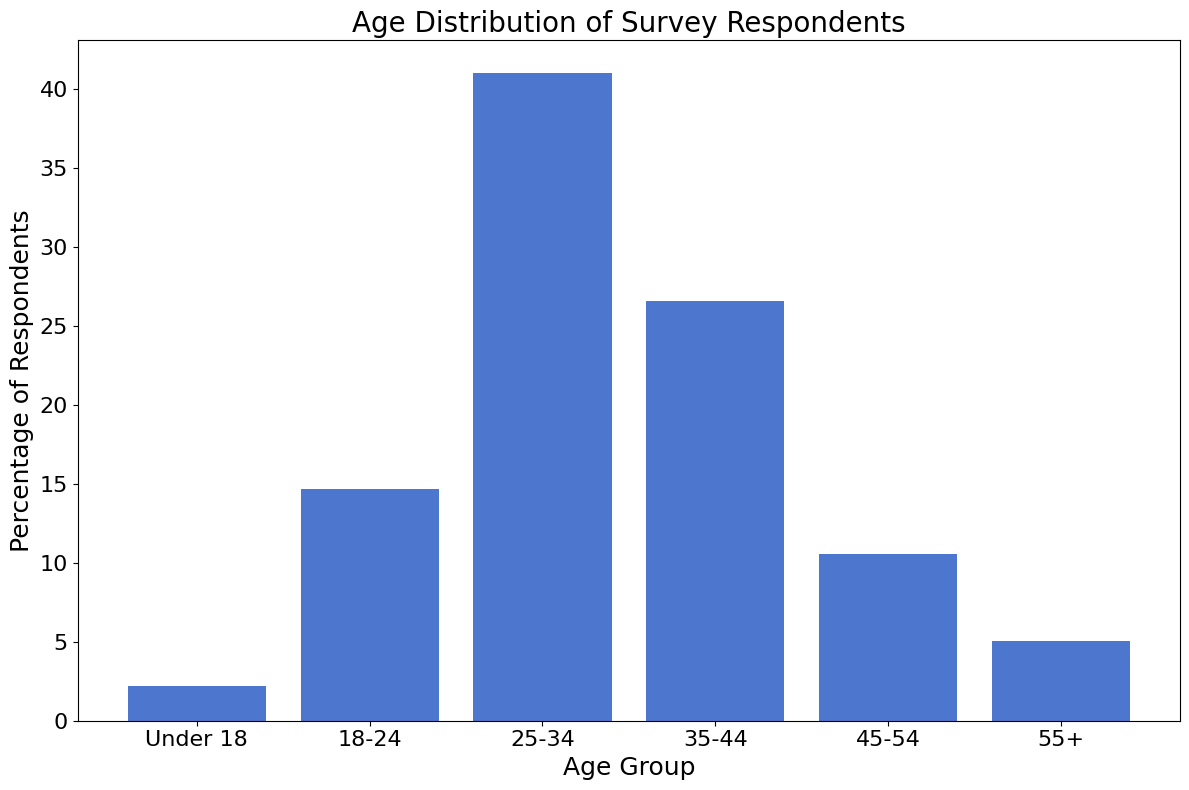
Gender#
Of the 522 survey respondents, 453 (87%) shared their gender.
An majority of respondents identify as male. Only about 11% of respondents identify as female.
Show code cell source
# Ignore empty fields and "prefer not to answer"
drop = np.logical_and(data['gender'] != '', data['gender'] != 'Prefer not to answer')
gender = data['gender'][drop]
labels, cnts = np.unique(gender, return_counts=True)
fig, ax = plt.subplots(figsize=(8, 8))
ax.pie(cnts, labels=labels, autopct='%1.1f%%')
ax.set_title("Gender Distribution");
fig.tight_layout()
glue('2021_num_gender', gluval(gender.shape[0], data.shape[0]), display=False)
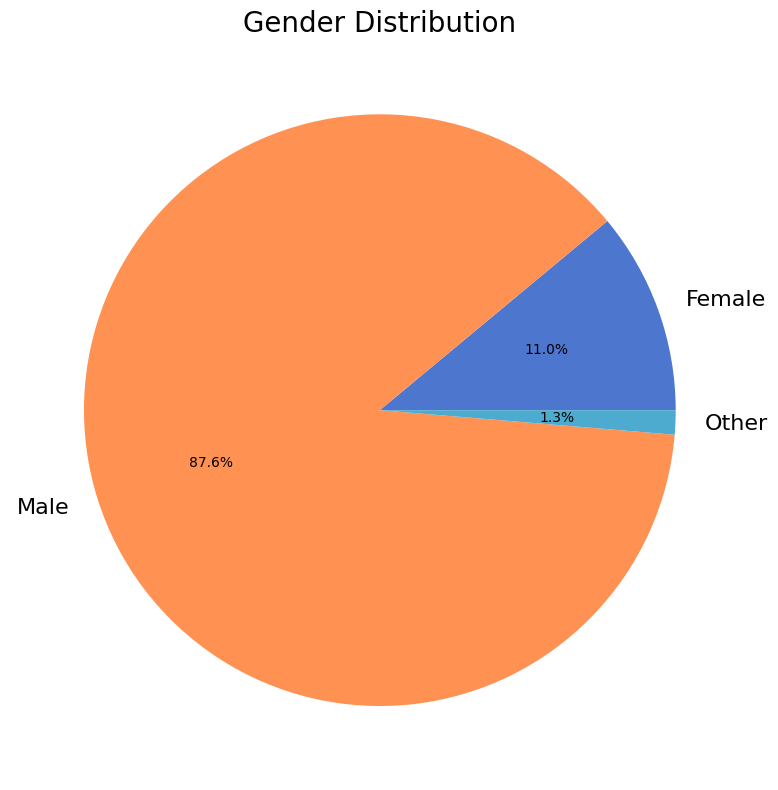
Language Preference#
Of the 522 respondents, 497 (95%) shared their preferred language.
Over 67% of respondents reported English as their preferred language.
Show code cell source
# Ignore empty fields
lang = data['lang'][data['lang'] != '']
# Self-reported language
lang_other = data['lang_other'][data['lang_other'] != '']
lang_other = capitalize(lang_other)
lang = np.concatenate((lang, lang_other))
labels, cnts = np.unique(lang, return_counts=True)
cnts = 100 * cnts / cnts.sum()
I = np.argsort(cnts)[::-1]
labels, cnts = labels[I], cnts[I]
# Create a summary table
with open('_generated/language_preference_table.md', 'w') as of:
of.write('| **Language** | **Preferred by % of Respondents** |\n')
of.write('|--------------|-----------------------------------|\n')
for lbl, percent in zip(labels, cnts):
of.write(f'| {lbl} | {percent:1.1f} |\n')
glue('2021_num_lang_pref', gluval(lang.shape[0], data.shape[0]), display=False)
Click to show/hide table
Language |
Preferred by % of Respondents |
|---|---|
English |
67.2 |
Other |
6.6 |
Spanish |
6.2 |
French |
5.4 |
Japanese |
5.0 |
Russian |
1.8 |
German |
1.4 |
Mandarin |
1.0 |
Portuguese |
0.6 |
Polish |
0.6 |
Swedish |
0.4 |
Czech |
0.4 |
Italian |
0.4 |
Turkish |
0.4 |
Chinise |
0.2 |
中文 |
0.2 |
Chinese |
0.2 |
Bulgarian |
0.2 |
Allemand |
0.2 |
Hungarian |
0.2 |
Dutch |
0.2 |
Hebrew |
0.2 |
Hindi |
0.2 |
Indonesian |
0.2 |
Korean |
0.2 |
“norwegian “ |
0.2 |
Country of Residence#
Of the 522 respondents, 440 (84%) shared their current country of residence. The survey saw respondents from 54 countries in all. A quarter of respondents reside in the United States.
The following chart shows the relative number of respondents from ~10 countries with the largest number of participants. For privacy reasons, countries with fewer than a certain number of respondents are not included in the figure, and are instead listed in the subsequent table.
Show code cell source
# Preprocess data
country = data['country'][data['country'] != '']
country = strip(country)
# Distribution
labels, cnts = np.unique(country, return_counts=True)
# Privacy filter
num_resp = 10
cutoff = (cnts > num_resp)
plabels = np.concatenate((labels[cutoff], ['Other']))
pcnts = np.concatenate((cnts[cutoff], [cnts[~cutoff].sum()]))
# Plot
fig, ax = plt.subplots(figsize=(8, 8))
ax.pie(pcnts, labels=plabels, autopct='%1.1f%%')
ax.set_title("Country of Residence");
fig.tight_layout()
# Map countries to continents
import pycountry_convert as pc
cont_code_to_cont_name = {
'NA': 'North America',
'SA': 'South America',
'AS': 'Asia',
'EU': 'Europe',
'AF': 'Africa',
'OC': 'Oceania',
}
def country_to_continent(country_name):
cc = pc.country_name_to_country_alpha2(country_name)
cont_code = pc.country_alpha2_to_continent_code(cc)
return cont_code_to_cont_name[cont_code]
c2c = np.vectorize(country_to_continent, otypes='U')
# Organize countries below the privacy cutoff by their continent
remaining_countries = labels[~cutoff]
continents = c2c(remaining_countries)
with open('_generated/countries_by_continent.md', 'w') as of:
of.write('| | |\n')
of.write('|---------------|-------------|\n')
for continent in np.unique(continents):
clist = remaining_countries[continents == continent]
of.write(f"| **{continent}:** | {', '.join(clist)} |\n")
glue('2021_num_unique_countries', len(labels), display=False)
glue(
'2021_num_country_respondents',
gluval(country.shape[0], data.shape[0]),
display=False
)
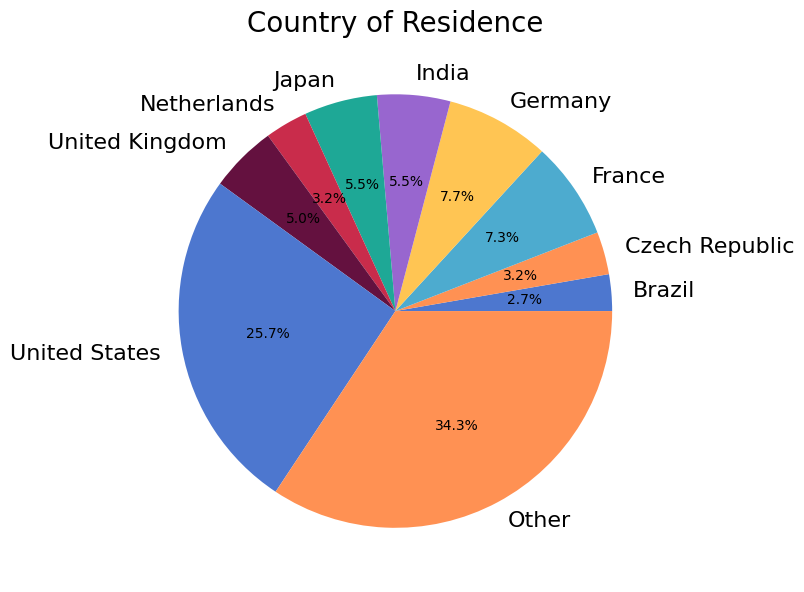
Africa: |
Egypt, Ghana, Kenya, Nigeria, South Africa, Zimbabwe |
Asia: |
Bangladesh, China, Indonesia, Israel, Malaysia, Pakistan, Singapore, South Korea, Turkey |
Europe: |
Austria, Belgium, Bulgaria, Denmark, Finland, Hungary, Iceland, Ireland, Italy, Latvia, Norway, Poland, Russia, Slovakia, Spain, Sweden, Switzerland, Ukraine |
North America: |
Canada, Cuba, Mexico |
Oceania: |
Australia, Vanuatu |
South America: |
Argentina, Chile, Colombia, Ecuador, Paraguay, Peru, Venezuela |
Education#
440 (84%) respondents shared their education history, spanning the range from pre-highschool graduation through Doctorate level with many other specialist degrees.
Generally, respondents are highly educated. Nine out of ten have at least a Bachelor’s degree and one in three holds a PhD.
The following figure summarizes the distribution for the highest degrees obtained by respondents.
Show code cell source
degree = data['degree'][data['degree'] != '']
labels, cnts = np.unique(degree, return_counts=True)
fig, ax = plt.subplots(figsize=(8, 8))
ax.pie(cnts, labels=labels, autopct='%1.1f%%', labeldistance=None)
ax.legend()
ax.set_title("Highest Level of Education");
fig.tight_layout()
glue('2021_num_education', gluval(degree.shape[0], data.shape[0]), display=False)
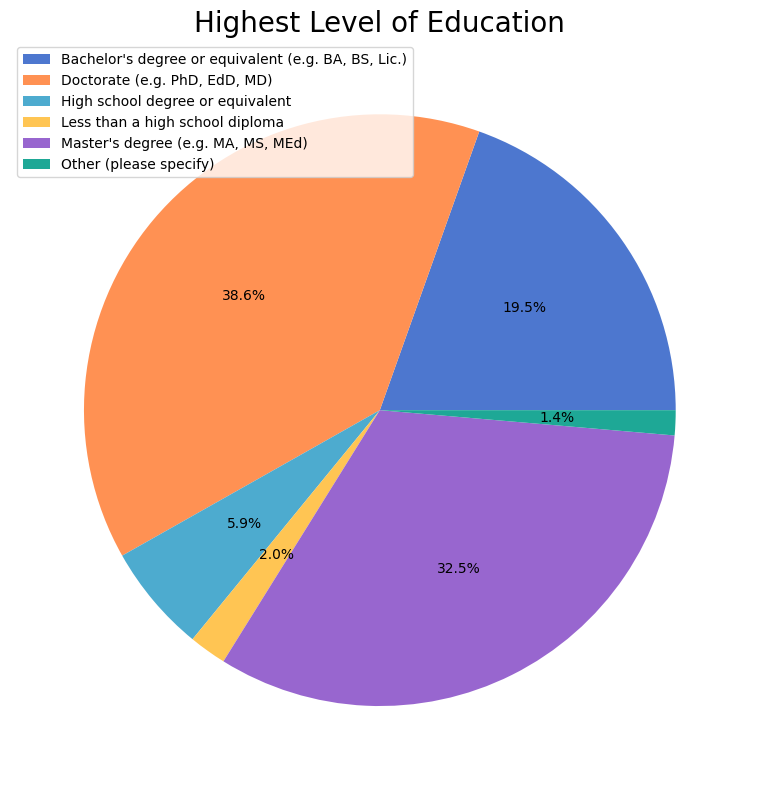
Job Roles#
205 (47%) of the 435 respondents who shared their occupation identify as an Data scientist, Scientist (in academia), or Software engineer.
Show code cell source
role = data['role'][data['role'] != '']
labels, cnts = np.unique(role, return_counts=True)
# Sort results by number of selections
inds = np.argsort(cnts)
labels, cnts = labels[inds], cnts[inds]
fig, ax = plt.subplots(figsize=(12, 8))
ax.barh(np.arange(len(cnts)), cnts, align='center')
ax.set_yticks(np.arange(len(cnts)))
ax.set_yticklabels(labels)
ax.set_xlabel("Number of Respondents")
ax.set_title("Current Role");
fig.tight_layout()
glue('2021_num_occupation', role.shape[0], display=False)
glue(
'2021_num_top_3_categories',
gluval(cnts[-3:].sum(), role.shape[0]),
display=False,
)
glue('2021_top_3_categories', f"{labels[-3]}, {labels[-2]}, or {labels[-1]}", display=False)
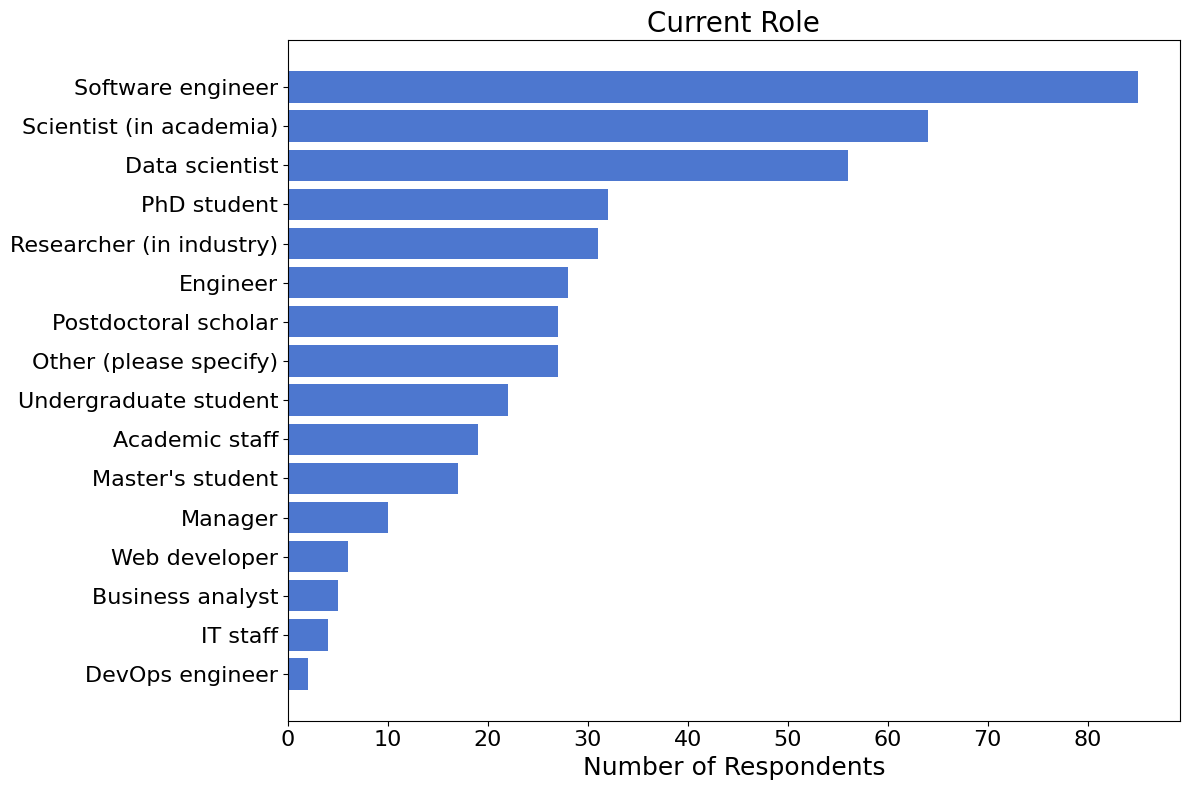
Show code cell source
# Ignore empty fields and "prefer not to answer"
drop = np.logical_and(data['surv2020'] != '', data['surv2020'] != 'Not sure')
surv2020 = data['surv2020'][drop]
labels, cnts = np.unique(surv2020, return_counts=True)
glue('2021_num_surv2020_respondents', gluval(surv2020.shape[0], data.shape[0]), display=False)
yes_percent = 100 * cnts[1].sum() / cnts.sum()
glue('2021_yes_percent', f"{yes_percent:1.1f}", display=False)
Experience and Usage#
Programming Experience#
68% of respondents have significant experience in programming, with veterans (10+ years) taking the lead. Interestingly, when it comes to using NumPy, noticeably more of our respondents identify as beginners than experienced users.
Show code cell source
fig, axes = plt.subplots(1, 2, figsize=(12, 6))
# Ascending order for figure
ind = np.array([-1, 0, 2, 3, 1])
for exp_data, ax in zip(('programming_exp', 'numpy_exp'), axes):
# Analysis
prog_exp = data[exp_data][data[exp_data] != '']
labels, cnts = np.unique(prog_exp, return_counts=True)
cnts = 100 * cnts / cnts.sum()
labels, cnts = labels[ind], cnts[ind]
# Generate text on general programming experience
glue(f'2021_{exp_data}_5plus_years', f"{cnts[-2:].sum():2.0f}%", display=False)
# Plotting
ax.bar(np.arange(len(cnts)), cnts)
ax.set_xticks(np.arange(len(cnts)))
ax.set_xticklabels(labels)
axes[0].set_title('General Programming Experience')
axes[0].set_ylabel('Percentage of Respondents')
axes[1].set_title('Experience with NumPy');
fig.autofmt_xdate();
fig.tight_layout();
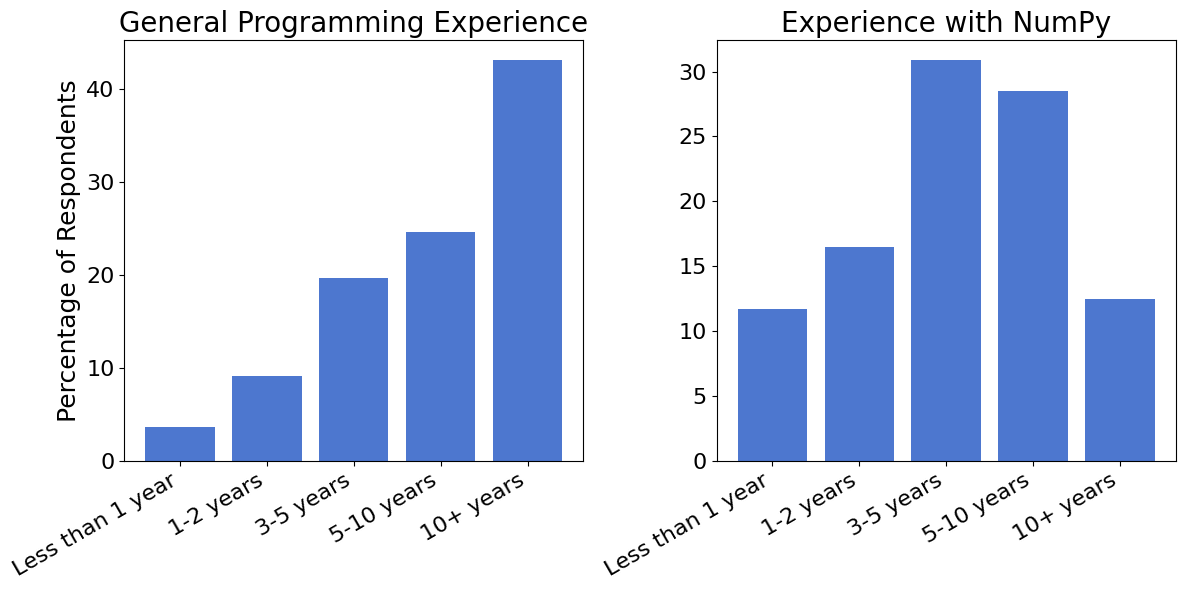
Programming Languages#
401 (77%) of survey participants shared their experience with other programming languages. 64% of respondents are familiar with np.str_(‘C / C++’), and 40% with np.str_(‘Matlab’).
Show code cell source
pl = data['prog_lang'][data['prog_lang'] != '']
num_respondents = len(pl)
glue('2021_num_proglang_respondents', gluval(len(pl), data.shape[0]), display=False)
# Flatten & remove 'Other' write-in option
other = 'Other (please specify, using commas to separate individual entries)'
apl = []
for row in pl:
if 'Other' in row:
row = ','.join(row.split(',')[:-2])
if len(row) < 1:
continue
apl.extend(row.split(','))
labels, cnts = np.unique(apl, return_counts=True)
cnts = 100 * cnts / num_respondents
I = np.argsort(cnts)
labels, cnts = labels[I], cnts[I]
fig, ax = plt.subplots(figsize=(12, 8))
ax.barh(np.arange(len(cnts)), cnts, align='center')
ax.set_yticks(np.arange(len(cnts)))
ax.set_yticklabels(labels)
ax.set_xlabel("Percentage of Respondents")
ax.set_title("Programming Language Familiarity")
fig.tight_layout()
# Highlight two most popular
glue('2021_num_top_lang', f"{cnts[-1]:2.0f}%", display=False)
glue('2021_top_lang', labels[-1], display=False)
glue('2021_num_2nd_lang', f"{cnts[-2]:2.0f}%", display=False)
glue('2021_second_lang', labels[-2], display=False)
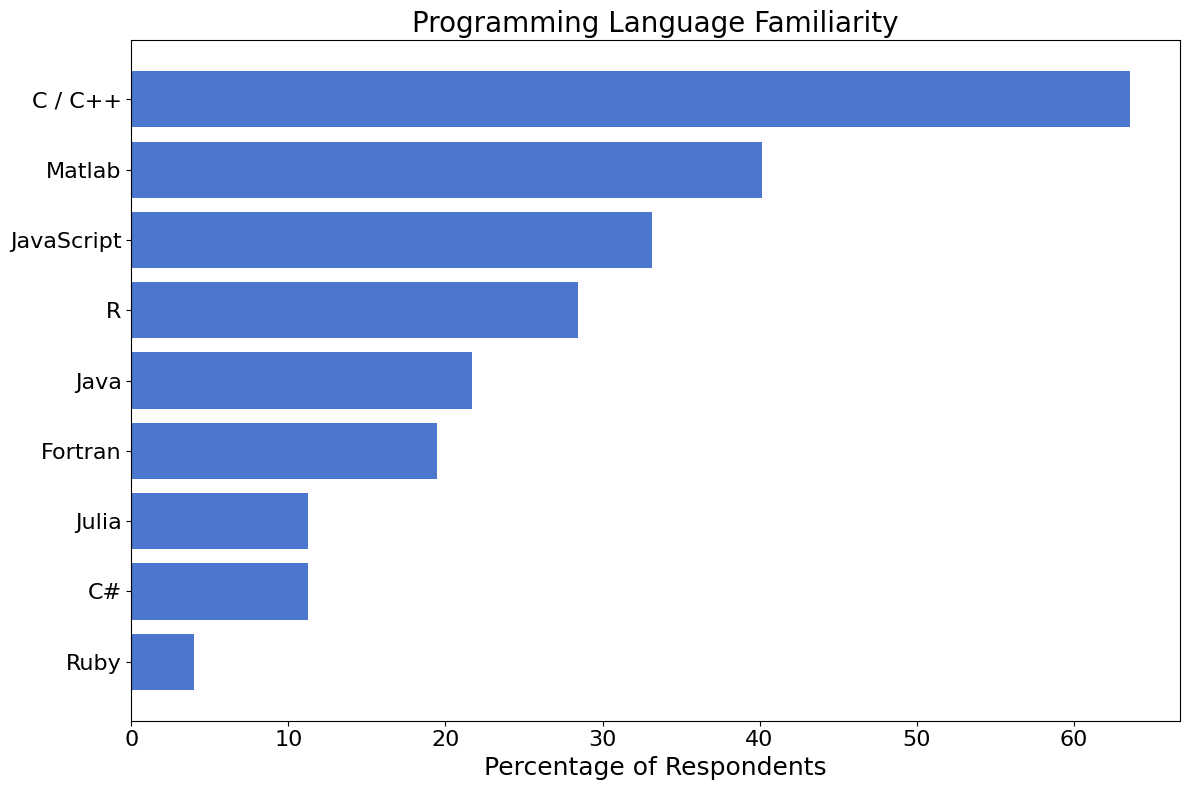
84 (21%) percent of respondents reported familiarity with computer languages other than those listed above. Of these, Rust was the most popular with 17 (4%) respondents using this language. A listing of other reported languages can be found below (click to expand).
Show code cell outputs
['"' '"cobol' '"tcl' '-' 'amigae' 'asembler mc68k' 'asembler x86'
'assembly' 'awk' 'bash' 'basic' 'clojure' 'cython' 'dart' 'dpl' 'elixir'
'elm' 'f#' 'forth' 'go' 'golang' 'haskel' 'haskell' 'idl' 'kotlin' 'lisp'
'llvm ir' 'logo' 'lua' 'mathematica' 'matlab' 'mysql' 'nim' 'nim lang'
'nix' 'none' 'none except python' 'objective-c' 'ocaml' 'pascal' 'perl'
'php' 'prolog' 'python' 'rust' 'scala' 'scheme' 'shell' 'sql' 'stata'
'swift' 'systemverilog' 't-sql' 'tcl' 'tcl/tk' 'tex' 'typescript' 'vba'
'verilog' 'visual basic' 'visual foxpro' 'what does familiar mean?'
'wolfram']
Code Sharing#
418 (80%) of survey participants shared information on how many others they typically share code with. Most respondents share code with 1-2 people.
Show code cell source
from numpy_survey_results.utils import flatten
share_code = data['share_code'][data['share_code'] != '']
labels, cnts = np.unique(flatten(share_code), return_counts=True)
# Sort categories in ascending order (i.e. "0", "1-2", "3-5", "5-10", "10+")
ind = np.array([0, 1, 3, 4, 2])
labels, cnts = labels[ind], cnts[ind]
fig, ax = plt.subplots(figsize=(12, 8))
ax.bar(
np.arange(len(labels)),
100 * cnts / share_code.shape[0],
tick_label=labels,
)
ax.set_ylabel('Percentage of Respondents')
ax.set_xlabel('Number of people you typically share code with')
fig.tight_layout()
# Highlights most popular
glue('2021_top_share', str(labels[np.argmax(cnts)]), display=False)
# Number who answered question
glue(
'2021_num_share_code',
gluval(share_code.shape[0], data.shape[0]),
display=False
)
